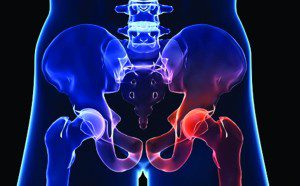By Dr. John C. Kagan, M.D.


Snapping hip syndrome can occur in several different areas around the hip. The hip joint is made up of the rounded end of the femur, or thighbone, where it fits into a socket in the pelvis. The socket, called the acetabulum, is covered in cartilage that seals the connection between the femur and the acetabulum. The femur and pelvis are connected by several ligaments that hold them together, and the ligaments are covered with tendons, which connect muscle tissues that control hip movement. Wherever the tendons and muscles slide over protrusions from the hip bones, snapping hip syndrome can occur. Tears in the cartilage that lines the hip socket can also cause the hip to snap or even lock up altogether.
People involved in activities that require extensive bending and flexing of the hip, whether in exercise or on the job, are most likely to suffer from snapping hip syndrome. Young athletes are also at risk, because their growing muscles and tendons are tight, particularly during growth spurts.
Depending on the degree of pain and loss of flexibility, treatment can range from self-treatment to steroid injections or surgery. For soft tissue injuries that aren’t excessively painful or motion-limiting, first try “HI-RICE”: hydration, ibuprofen, rest, ice, compression and elevation. Often, these techniques, along with avoiding the exercises or exertions that strain the muscles and tendons in the first place, are sufficient to allow the tendons to heal. Physical therapy with prescribed stretches to strengthen the muscle tissue around the hip may also be used.
If rest and over-the-counter analgesics such as ibuprofen are insufficient, your doctor may perform ultrasound, MRI or X-ray diagnostic imaging to determine where exactly the tendon injury or swelling is located. Depending on the location of the inflammation, the doctor may recommend corticosteroid injection to help reduce inflammation.
Rarely, severe instances of snapping hip syndrome require surgical intervention. Depending on the location and cause of the snapping, different types of surgery may be required. If the snapping hip syndrome is caused by torn cartilage, the surgeon may be able to repair it with minimally invasive arthroscopic surgery, using a camera to guide small surgical instruments. Other types of injury may require a traditional, open surgical incision, which will also require a longer recovery period.
If you’ve noticed the symptoms of snapping hip syndrome, consult your orthopedist to determine what can be done to address it. When caught early enough, snapping hip syndrome can often be alleviated without surgery or major medical intervention.
If you have concerns hip injuries or other orthopedic disorders, Dr. John C. Kagan and his staff are ready to answer your questions. Dr. Kagan has more than 30 years of experience as an orthopedic surgeon and sports medicine specialist treating patients in Southwest Florida. He specializes in treating patients with knee, shoulder and hip pain, as well as general orthopedics and hand surgery. For more information, visit www.kaganortho.com or call 239-936-6778.
 Southwest Florida's Health and Wellness Magazine Health and Wellness Articles
Southwest Florida's Health and Wellness Magazine Health and Wellness Articles

